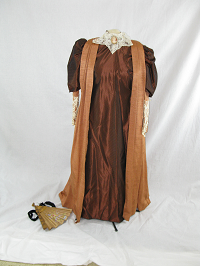1890s
Tea gown. Tea gowns, introduced in the 1870s, grew in popularity to become elaborate showpieces. This gown was copied from a design by Worth of Paris. It is unique in design and materials. It is a long flowing caftan of rust colored cloth draped over a fitted gown with sheath like closeness. The caftan front frames the figure with wide reviers. The fullness is narrowly massed on the shoulders. The full back falls in watteau-like pleats. The gown beneath is fitted by darts and fastens invisibly on the left. The collar is fronted with lace and deep cuffs of lace trim the sleeves. The gown was pictured in Harper's Bazaar, December 1891. Worth was an architect and built his gowns over a corset which forced a woman's body into the shape he wanted.
While petticoat materials and colors started to change in the 1890s, not every woman had the inclination or the means to purchase the colored silks that "dame fashion" dictated. A woman of modest means might wear her winter petticoat of wool rather than silk. This example is an antique. It was considered stable enough to use sparingly in the shows because of the bottom detail. What was worn beneath? A corset and knickers, of course!
Click photo for detailed views.


